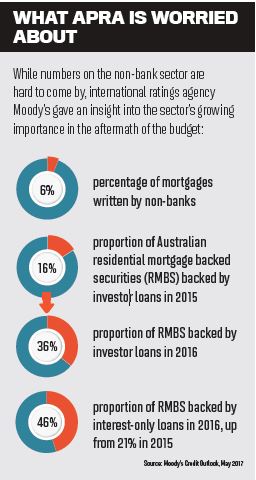The Macquarie Group 1Q 18 update shows the group is travelling well, with no significant on-off items in the quarter. The Bank Group APRA Basel III Common Equity Tier 1 capital ratio was 10.9 per cent at 30 June 2017, down from 11.1 per cent at 31 March 2017.
 Macquarie currently expects the year ending 31 March 2018 (FY18) combined net profit contribution from operating groups to be broadly in line with the year ended 31 March 2017 (FY17).
Macquarie currently expects the year ending 31 March 2018 (FY18) combined net profit contribution from operating groups to be broadly in line with the year ended 31 March 2017 (FY17).
APRA’s proposal to establish ‘unquestionably strong’ Australian banking sector capital ratios by 2020 would increase Macquarie Bank Limited’s minimum capital requirements by approximately $A1.4 billion.
The estimated annualised cost of the bank tax has the same effect as increasing Macquarie Bank’s Australian effective tax rate from 34 per cent to 41 per cent they said.
The Group’s short-term outlook remains subject to:
- market conditions
- the impact of foreign exchange; and
- potential regulatory changes and tax uncertainties
The Australian mortgage portfolio of $A29.4 billion increased two per cent on 31 March 2017.
Macquarie Asset Management (MAM) had $A460.8 billion in assets under management at 30 June 2017, down four per cent on 31 March 2017, largely due to net asset realisations in Macquarie Infrastructure and Real Assets (MIRA), partially offset by favourable market and foreign exchange movements. MIRA’s equity under management of $A74.2 billion was down four per cent from $A77.2 billion at 31 March 2017. 1Q18 included performance fees from several funds including Macquarie Atlas Roads. During the quarter, MIRA invested equity of $A3.0 billion across four acquisitions and seven follow-on investments in infrastructure and real estate in five countries. Macquarie Investment Management was awarded over $A3.1 billion in new institutional mandates across nine strategies from clients in five countries and Macquarie Specialised Investment Solutions was awarded over $A800 million of new and additional infrastructure debt mandates.
Corporate and Asset Finance’s asset and loan portfolio of $A36.2 billion at 30 June 2017, was broadly in line with 31 March 2017. During the quarter, there were portfolio additions of $A0.9 billion in corporate and real estate lending across new primary financings and secondary market acquisitions. In addition, $A0.8 billion of motor vehicle and equipment leases and loans were securitised.
Banking and Financial Services had total BFS deposits6 of $A47.3 billion at 30 June 2017, up six per cent on 31 March 2017. The Australian mortgage portfolio of $A29.4 billion increased two per cent on 31 March 2017, funds on platform7 of $A79.1 billion increased ten per cent on 31 March 2017 largely due to the final migration of full service broking accounts to the Vision platform, and the business banking loan portfolio of $A6.7 billion increased three per cent on 31 March 2017. During the quarter, BFS entered into exclusive due diligence with Morgan Stanley to provide administration services and develop a new white labelled Wrap offering. BFS won Best Digital Banking Offering and Most Innovative Card Offering at the 2017 Australian Retail Banking Awards.
Commodities and Global Markets saw client hedging and trading opportunities remain steady across the commodities platform, and experienced continued strong customer activity in foreign exchange, interest rates and futures markets, which was driven by ongoing market volatility. CGM also experienced increased equity capital markets activity and market turnover in Cash Equities. During the quarter, CGM entered into an agreement to acquire Cargill’s North American Power and Gas business to expand the geographic and service coverage in key markets in the region. CGM also announced the merger of the Energy Markets and Metals, Mining and Agriculture divisions to form one commodities division called Commodity Markets and Finance.
Macquarie Capital experienced increased client activity in debt capital markets, while equity capital markets and M&A activity remained subdued compared to the prior corresponding period. In 1Q18, 97 deals were completed at $A45 billion, up on 1Q17 and broadly in line with 4Q17 (by value)8. The principal book performed in line with expectations. Macquarie Capital was ranked No.1 for global Infrastructure Finance financial advisory9. Macquarie Capital was also ranked No.1 for announced and completed M&A deals10 and No.1 for IPO and ECM deals in Australia10.










